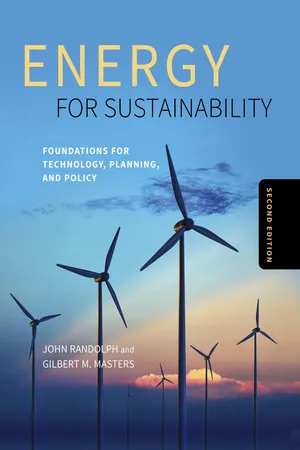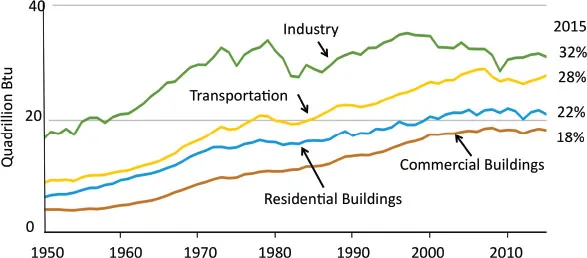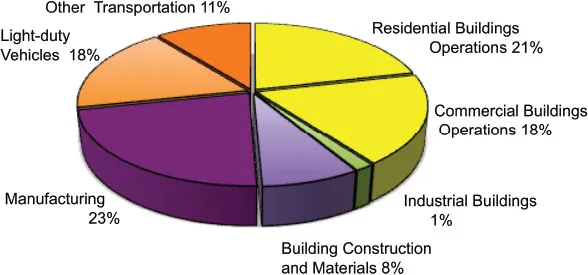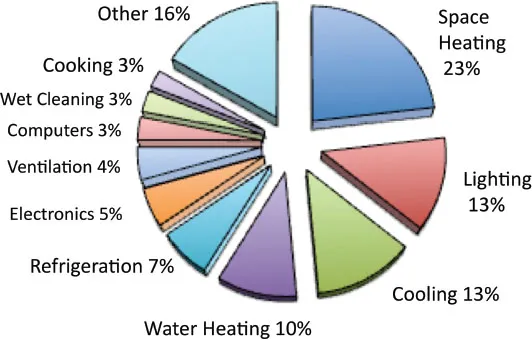
eBook - ePub
Energy for Sustainability, Second Edition
Foundations for Technology, Planning, and Policy
- 664 pages
- English
- ePUB (mobile friendly)
- Available on iOS & Android
eBook - ePub
Energy for Sustainability, Second Edition
Foundations for Technology, Planning, and Policy
About this book
Despite a 2016-18 glut in fossil fuel markets and decade-low fuel prices, the global transformation to sustainable energy is happening. Our ongoing energy challenges and solutions are complex and multidimensional, involving science, technology, design, economics, finance, planning, policy, politics, and social movements.
The most comprehensive book on this topic, Energy for Sustainability has been the go-to resource for courses. This new edition has been thoroughly revised and updated to inform and guide students and practitioners who will steer this transformation.
Drawing on a combined 80 years of teaching experience, John Randolph and Gilbert Masters take a holistic and interdisciplinary approach. Energy for Sustainability can help techies and policymakers alike understand the mechanisms required to enable conversion to energy that is clean, affordable, and secure. Major revisions to this edition reflect the current changes in technology and energy use and focus on new analyses, data, and methods necessary to understand and actively participate in the transition to sustainable energy.
The book begins with energy literacy, including patterns and trends, before covering the fundamentals of energy related to physics, engineering, and economics. The next parts explore energy technologies and opportunities in three important energy sectors: buildings, electricity, and transportation. The final section focuses on policy and planning, presenting the critical role of public policy and consumer and investor choice in transforming energy markets to greater sustainability. Throughout the book, methods for energy and economic analysis and design give readers a quantitative appreciation for and understanding of energy systems. The book uses case studies extensively to demonstrate current experience and illustrate possibilities.
Students will gain an understanding of what it takes to achieve clean, affordable, sustainable energy. Supplemental materials are available at www.islandpress.org/energy
The most comprehensive book on this topic, Energy for Sustainability has been the go-to resource for courses. This new edition has been thoroughly revised and updated to inform and guide students and practitioners who will steer this transformation.
Drawing on a combined 80 years of teaching experience, John Randolph and Gilbert Masters take a holistic and interdisciplinary approach. Energy for Sustainability can help techies and policymakers alike understand the mechanisms required to enable conversion to energy that is clean, affordable, and secure. Major revisions to this edition reflect the current changes in technology and energy use and focus on new analyses, data, and methods necessary to understand and actively participate in the transition to sustainable energy.
The book begins with energy literacy, including patterns and trends, before covering the fundamentals of energy related to physics, engineering, and economics. The next parts explore energy technologies and opportunities in three important energy sectors: buildings, electricity, and transportation. The final section focuses on policy and planning, presenting the critical role of public policy and consumer and investor choice in transforming energy markets to greater sustainability. Throughout the book, methods for energy and economic analysis and design give readers a quantitative appreciation for and understanding of energy systems. The book uses case studies extensively to demonstrate current experience and illustrate possibilities.
Students will gain an understanding of what it takes to achieve clean, affordable, sustainable energy. Supplemental materials are available at www.islandpress.org/energy
Frequently asked questions
Yes, you can cancel anytime from the Subscription tab in your account settings on the Perlego website. Your subscription will stay active until the end of your current billing period. Learn how to cancel your subscription.
No, books cannot be downloaded as external files, such as PDFs, for use outside of Perlego. However, you can download books within the Perlego app for offline reading on mobile or tablet. Learn more here.
Perlego offers two plans: Essential and Complete
- Essential is ideal for learners and professionals who enjoy exploring a wide range of subjects. Access the Essential Library with 800,000+ trusted titles and best-sellers across business, personal growth, and the humanities. Includes unlimited reading time and Standard Read Aloud voice.
- Complete: Perfect for advanced learners and researchers needing full, unrestricted access. Unlock 1.4M+ books across hundreds of subjects, including academic and specialized titles. The Complete Plan also includes advanced features like Premium Read Aloud and Research Assistant.
We are an online textbook subscription service, where you can get access to an entire online library for less than the price of a single book per month. With over 1 million books across 1000+ topics, we’ve got you covered! Learn more here.
Look out for the read-aloud symbol on your next book to see if you can listen to it. The read-aloud tool reads text aloud for you, highlighting the text as it is being read. You can pause it, speed it up and slow it down. Learn more here.
Yes! You can use the Perlego app on both iOS or Android devices to read anytime, anywhere — even offline. Perfect for commutes or when you’re on the go.
Please note we cannot support devices running on iOS 13 and Android 7 or earlier. Learn more about using the app.
Please note we cannot support devices running on iOS 13 and Android 7 or earlier. Learn more about using the app.
Yes, you can access Energy for Sustainability, Second Edition by John Randolph,Gilbert M. Masters in PDF and/or ePUB format, as well as other popular books in Tecnología e ingeniería & Sostenibilidad en la arquitectura. We have over one million books available in our catalogue for you to explore.
Information
SECTION III:
BUILDINGS AND ENERGY

Chapter 6: Energy Efficiency for Buildings
Chapter 7: Solar Energy for Buildings: Approaching Zero Net Energy
Chapter 8: Whole Building to Zero Net Energy
Chapter 6
Energy Efficiency for Buildings
Energy for buildings is the most important sector of energy demand in the United States. Energy to provide the heating, cooling, lighting, water heating, and all the other energy demands for building operations accounts for 40% of U.S. primary energy demand. Transportation accounts for 28%, and the remaining 32% is associated with the industrial sector (Figure 6.1).
Although the energy needed to operate buildings shown in Figure 6.1 is sizable, there is an additional energy burden associated with the energy needed to manufacture building materials, transport them to construction sites, and then repair and remodel those buildings over time. As Figure 6.2 shows, when that embodied energy is included, the total energy demand for the building sector grows to almost half of all U.S. primary energy. This embodied energy, along with some very important policy and planning approaches to improving building energy efficiency, will be described in Chapter 8.
Buildings also use almost three-fourths of the electricity generated in the United States, which means that buildings are responsible for a corresponding fraction of the carbon emissions and other pollution associated with power plants. In total, almost 40% of all U.S. carbon emissions are attributed to the building sector.
In this chapter we will look carefully at how better windows, more insulation, tighter building envelopes, better ducts, and other features can reduce the energy demand for heating and cooling in buildings. We’ll then describe conventional heating and air conditioning systems used to satisfy the remaining space conditioning demand. In the next chapter, we will focus on using solar energy to help heat buildings in the winter without overheating them in the summer, provide natural daylight for illumination, and supply energy for water heating.
6.1 Residential and Commercial Buildings
Figure 6.3 presents the principal end uses for energy in buildings. Almost two-thirds of the total demand is for space heating and cooling, lighting, and water heating, and the rest consists of a large number of small things, mostly associated with things we plug into the wall. Controlling those plug loads is an emerging challenge in terms of both total energy demand and the times of day during which that power is needed.
As noted in Figure 6.2, the energy needed to operate residential buildings is higher than that consumed by commercial buildings. We live in houses and apartments, so we all have intuitive knowledge of the energy demands of those dwellings, but it is important to note that commercial buildings, such as banks, schools, shopping centers, and office buildings, have energy characteristics quite different from the ones we normally focus on in small residential structures. An office building is not just a big house.

Figure 6.1 Historical Distribution of Energy Sectors in the U.S.
(Data source: U.S. EIA, 2015)

Figure 6.2 Distribution of Annual Energy Consumption in the U.S.
When embodied energy associated with construction and maintenance is included, buildings account for almost half of all U.S. energy.
Larger buildings have a smaller surface-to-volume ratio, which reduces the importance of heat transfer through the building envelope per unit of floor space. Moreover, within those square feet of floor space a lot more is going on. Office buildings are illuminated much more brightly and uniformly than homes to accommodate the needs of workers, and most of that energy ends up as waste heat. Moreover, the density of people, copy machines, computers, and other plug loads increases, driving up the internal thermal gains, which means these buildings can potentially pretty much heat themselves until the ambient temperature drops well below the indoor temperature.
One way to see the impact of these differences between big buildings and small ones is to plot out the major energy demands for residential and commercial buildings, as shown in Figure 6.4. As can be seen there, plain old residential space heating is the dominant single use of energy in buildings (that’s why we will spend so much time on it in this chapter). The next most important sector is lighting in commercial buildings. We’ll discuss that in Chapters 7 and 8. So when do we need lights in most commercial buildings? It is in the daytime, when there is an abundance of light outside, provided cleanly and freely by the sun. If we could take greater advantage of that natural daylighting, we could make a significant dent in commercial building energy demand, not only by reducing lighting power itself but also by cutting the accompanying extra demand for air conditioning to carry away lighting’s waste heat.
Figure 6.4 also shows the importance of residential water heating, which will be addressed in the next chapter. Interestingly, cooling isn’t the dominant energy demand for either type of building. That conclusion is based on national statistics, but of course in certain climate areas cooling is overwhelmingly important. Another factor that makes cooling more important than Figure 6.4 makes it appear to be is that it drives up the electricity demand in the middle of hot days when the grid is running at maximum capacity. Reducing cooling loads can help avoid blackouts and also reduce our need to build and operate inefficient peaker power plants.

Figure 6.3 Distribution of Primary Energy Demand for U.S. Buildings
Heating, cooling, and lighting account for almost half of the 40 quads of building energy consumption in the U.S.
(Data source: U.S. EIA, 2015)

Figure 6.4 Major Sectors of Energy Use in U.S. Buildings
Residential space heating and commercial lighting are significant building loads.
(Data source: U.S. DOE, 2012)
6.2 Site Energy versus Primary Energy
Some data sources use site energy to characterize building energy demand, whereas others use primary energy. What’s the difference?
The key difference is in how the electrical power delivered to a building is counted. Primary energy refers to all the energy inputs that are needed to deliver a unit of energy to the site, which means if electricity is being delivered, then the lost energy at the power plant and transmission lines is included. Site energy, on the other hand, ignores those losses.
Consider the example shown in Figure 6.5, in which the ene...
Table of contents
- Cover
- Title Page
- Copyright
- Dedication
- Contents
- Preface
- Acknowledgments
- Section I: Energy Patterns and Trends
- Section II: Energy Fundamentals
- Section III: Buildings and Energy
- Section IV: Sustainable Electricity
- Section V: Sustainable Transportation and Land Use
- Section VI: Energy Policy and Planning
- References and Further Reading
- Index